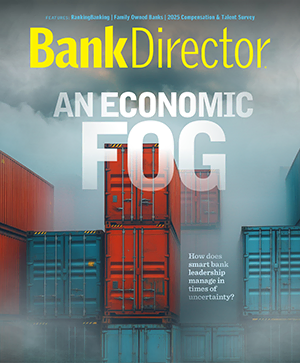David Benskin is the Founder and CEO of Wealth Access, the leading wealth data insights platform, pioneering the transformation of wealth management in banking. Formerly a First Vice President and partner on a Merrill Lynch Private Banking and Investments team, David spent over thirteen years with the company. Today, he helps banks recognize and capture the revenue potential of wealth management by leading with data-driven solutions.

There’s a Better Way to Think About Your Technology
Community banks need to better understand how their technology can unify different business lines, such as wealth management, and improve the client experience.
Brought to you by Wealth Access Inc.

To stay in the game, banks must stop planning around the edges and start building around the core.
Too much of what’s called strategic planning in banking is reactive — responding to market shifts, technology trends or regulatory changes. But if your plan doesn’t put integration at the center, from data and technology to the client experience, you’re not planning for the future. You’re just bracing for it.
Community banks are behind, not just in technology but in how they think about it. Tech has been treated as spend, not strategy, and systems are built to capture data, not connect it. Sales and marketing have often prioritized volume over value rather than maximizing what already exists within the client base.
In particular, wealth management is a strategic growth opportunity that can no longer sit on the sidelines. And neither can technology. If you’re not investing in both together, you’re not building a future-ready bank.
The challenge for bank boards and leadership is clear: Plan for integrated services that unify data, technology and client experience, across all lines of business.
1. Build a Roadmap That Merges Deposits, Loans and Wealth
Strategic integration doesn’t happen overnight. For many community banks, the path forward starts with a roadmap that aligns technology, talent and timing across business lines. It doesn’t have to be all-encompassing, but it must deliver small wins that build momentum.
A strong road map reduces reliance on any single core system and embraces modular innovation that connects systems and experiences. It also maps client journeys across deposits, loans and wealth to identify where integration can deliver the most immediate value.
Key steps include:
- Prioritizing quick wins, such as linking deposit data to wealth triggers.
- Partnering with fintechs or core providers that support plug-in capabilities.
- Layering in new tools without overhauling legacy systems.
The goal isn’t to rip and replace. It’s to evolve.
2. Empower Teams With Shared Client Views
Technology alone won’t drive integration. People will. Yet in many banks, frontline teams still operate in silos. Commercial bankers, retail staff and wealth advisers often engage the same client without seeing the full picture — or talking to each other. This disconnect limits cross-sell opportunities, weakens relationships and creates friction in the client experience.
To change that, banks need to equip teams with shared, role-based views of the client that are accessible across departments. This means:
- Implementing dashboards that surface relevant insights.
- Enabling collaboration tools that connect bankers and advisers in real time.
- Aligning incentives and training to encourage cross-functional engagement.
At Bank Director’s C-Suite Summit, several institutions described data strategy as knowledge management, not just for analytics but to empower people. When everyone sees the same client story, collaboration becomes not just possible but powerful.
3. Embed Digital Advice Where Clients Already Bank
Clients don’t want more apps or providers. They want more value from the platforms they already use. Embedding digital wealth tools into existing business, retail and commercial banking portals allows banks to meet clients where they are without adding friction.
This could include:
- Goal-based planning modules in online banking.
- Investment insights in treasury or cash management portals.
- Retirement calculators for small business owners.
These tools enhance the client experience and extend the reach of wealth services to segments that may never walk into a branch or meet with an adviser. By integrating advice into everyday banking, banks can democratize access to financial planning and deepen relationships.
This is especially important as banks look to scale what they already do well. Small and midsize business (SMB) banking, highlighted at the C-Suite Summit as a major growth opportunity, is a natural place to embed wealth services into their platforms, like planning tools.
The Boardroom Mandate: Make Integration the Strategy
Integration isn’t a technology project: It’s a business strategy. And it must be owned at the highest levels of the organization. Start asking yourselves the harder questions:
- Are we building around the client or around our organizational chart?
- Are we investing in systems that connect or just maintain?
- Are we empowering our teams to collaborate or just coexist?
Wealth is no longer a niche offering. It is a core lever for growth. And technology is no longer a back-office function. It is the infrastructure of modern banking. When these two forces are aligned strategically, operationally and culturally, banks can move from reactive to resilient.
The institutions that win the next decade won’t be the ones with the biggest budgets. They’ll be the ones with the clearest vision for how to integrate what they already have and deliver more value from within.


